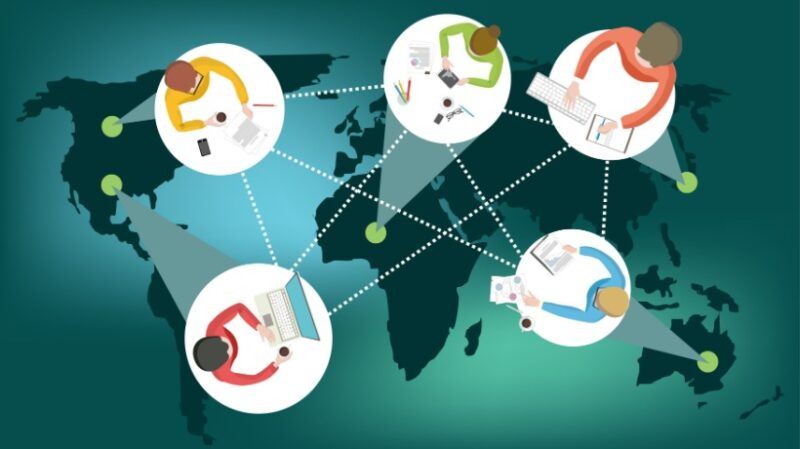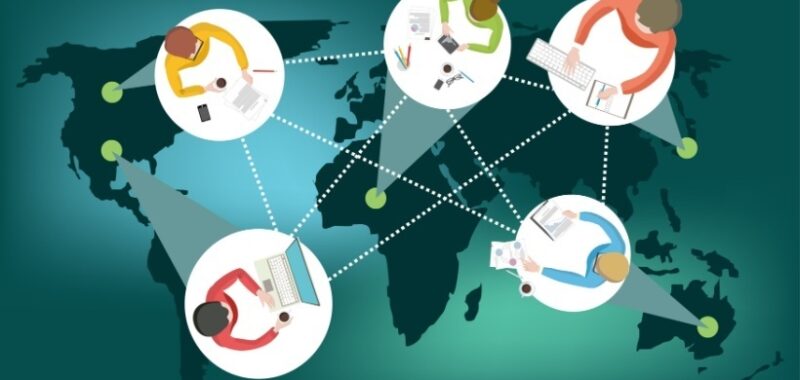
How Remote Work Is Changing Employee Training
As remote work becomes increasingly prevalent, the way organizations approach employee training is undergoing a significant transformation. Remote work also impacts training. The shift from traditional office environments to virtual workplaces is not just a change in location; it’s a fundamental rethinking of how training is delivered and the content that drives it.
Transforming Traditional Training Approaches
Traditional training methods often relied on face-to-face interactions, in-person workshops, and hands-on demonstrations. While these approaches have their benefits, they can be less effective in a remote setting. The lack of physical presence can lead to disengagement and challenges in collaboration.
To adapt, organizations are exploring a variety of online training formats, including webinars, eLearning modules, and virtual simulations. These methods provide flexibility and accessibility, allowing employees to learn at their own pace and revisit content as needed. Moreover, leveraging multimedia elements—such as videos, interactive quizzes, and gamification—enhances engagement and retention.
Rethinking Training Delivery And Content
With remote work, organizations must reconsider not just how they deliver training but also what content is relevant. Training programs must now reflect the unique challenges and dynamics of remote work, emphasizing skills such as digital communication, self-management, and adaptability. Moreover, remote training should foster collaboration and connection among team members, even when they’re miles apart. Incorporating opportunities for peer learning and mentorship can help build a sense of community and support, which is often lacking in remote environments.
Adapting Traditional Training Methods For Remote Teams
As the shift to remote work continues, organizations face the challenge of adapting traditional training methods to ensure effectiveness in a virtual environment. While face-to-face training has long been the standard, its limitations become apparent when employees are dispersed across various locations.
Limitations Of Traditional Training Methods
Traditional training methods, such as in-person workshops, classroom sessions, and hands-on demonstrations, often rely heavily on physical presence and direct interaction. These approaches can lead to several challenges in a remote context:
- Engagement issues
Without the energy of a physical classroom, it can be difficult to maintain participant engagement. - Logistical barriers
Scheduling conflicts, varying time zones, and technology access can hinder participation. - Limited interaction
Opportunities for spontaneous discussions and collaborative learning may be reduced.
Recognizing these limitations is the first step toward effectively adapting training for remote teams.
Strategies For Adapting Training Methods
To bridge the gap between traditional training and remote learning, organizations can implement several strategies:
- Virtual classroom cessions
Convert in-person training into interactive webinars or video conferences. Use breakout rooms for group discussions to mimic small group interactions. - Asynchronous learning modules
Develop eLearning courses that allow employees to engage with content at their own pace. Incorporate multimedia elements like videos, infographics, and quizzes to enhance the learning experience. - Simulations and role-playing
Use virtual simulations to create realistic scenarios that employees can navigate. This approach is particularly effective for skills like customer service, sales, and emergency response. - Hands-on virtual experiences
For training that requires practical skills, consider using Augmented Reality (AR) or Virtual Reality (VR) tools to provide immersive experiences. - Peer learning opportunities
Facilitate knowledge sharing through virtual mentorship programs or peer-led sessions, fostering collaboration and community among remote workers.
Examples Of Successful Adaptations
Various industries have successfully adapted their training methods for remote teams:
- Healthcare
Medical institutions have shifted to virtual simulations for training healthcare professionals. These simulations replicate real-life scenarios, allowing practitioners to develop skills in a controlled, risk-free environment. - Technology
Software companies have embraced online coding boot camps, where participants engage in live coding exercises, collaborate on projects, and receive instant feedback from instructors. - Sales
Many sales organizations have implemented virtual role-playing exercises, allowing teams to practice pitches and objections in a safe environment while receiving immediate feedback.
Remote Work Impacts Training: Managing Expectations For Remote Learning Outcomes
As organizations adapt to the remote work landscape, managing expectations for training outcomes becomes increasingly crucial. Setting realistic goals for remote training effectiveness not only enhances learning experiences but also fosters a culture of accountability and continuous improvement.
Setting Realistic Goals And Expectations
One of the first steps in managing expectations is establishing clear, achievable goals for remote training programs. Unlike traditional settings, where the environment is more controlled, remote learning can introduce variables that impact outcomes, such as technology access, self-discipline, and varying levels of engagement. To create realistic goals, consider the following:
- Understand learner needs
Assess the existing skill levels of participants and tailor training objectives accordingly. This personalization helps ensure that goals are both relevant and attainable. - Align training with business objectives
Goals should not only focus on individual learning but also tie into broader organizational outcomes. Clear connections between training and business goals enhance motivation and relevance. - Set incremental milestones
Break down larger goals into smaller, manageable milestones. This approach allows for celebrating progress and provides learners with a clear path to success.
Importance Of Continuous Feedback And Assessment
Continuous feedback is a vital component of effective remote learning. Unlike in-person settings, where trainers can gauge engagement and comprehension through body language and immediate responses, remote environments require intentional strategies for feedback collection. Key practices include:
- Regular check-ins
Schedule consistent one-on-one or group check-ins to discuss progress, address challenges, and adjust learning plans as needed. - Utilize surveys and polls
Implement short surveys after training sessions to gather immediate feedback on content effectiveness, engagement levels, and areas for improvement. - Encourage peer feedback
Foster a culture where participants can give and receive feedback among themselves, enhancing collaborative learning.
Strategies For Measuring Training Success And Learner Satisfaction
Measuring training success and learner satisfaction in remote environments involves both qualitative and quantitative approaches:
- Learning assessments
Incorporate quizzes, tests, or practical assessments to evaluate knowledge retention and application. Pre- and post-training assessments can highlight growth areas. - Track engagement metrics
Use analytics tools to monitor participation rates, session attendance, and completion rates. These metrics can provide insights into engagement levels and identify potential drop-off points. - Solicit testimonials and case studies
Encourage participants to share their experiences through testimonials or case studies, providing qualitative insights into the training’s impact on their roles. - Continuous improvement loop
Use gathered data to refine training programs continuously. This iterative approach ensures that training evolves in response to learner needs and organizational changes.
The Role Of Flexibility In Remote Learning Strategies
In the realm of remote learning, flexibility has emerged as a crucial component of effective training strategies. As employees navigate the complexities of working from home—balancing personal responsibilities, varying time zones, and different work environments—flexible training programs can significantly enhance engagement and learning outcomes.
The Benefits Of Flexibility In Training Schedules And Formats
Flexibility in training schedules allows remote employees to engage with learning materials when it suits them best. This adaptability is particularly beneficial in a remote setting, where individuals may have differing availability due to personal commitments or time zone differences. Key benefits of flexible training include:
- Enhanced engagement
Employees are more likely to participate in training when they can choose the time and format that works for them, resulting in higher engagement levels. - Improved retention
When learners have control over their schedules, they can absorb information at their own pace, leading to better retention and understanding of the material. - Reduced stress
Flexibility alleviates the pressure of rigid training schedules, allowing employees to balance learning with their daily responsibilities, which can reduce anxiety and burnout.
The Power Of Self-Paced Learning And Personalized Training Paths
Self-paced learning is a cornerstone of flexible training programs. This approach empowers employees to take charge of their learning journey, allowing them to progress through materials at their own speed. The benefits of self-paced learning include:
- Tailored learning experiences
Employees can focus on areas where they need improvement while skipping over content they already understand. This personalized approach caters to diverse skill levels and learning preferences. - Increased motivation
When learners have agency over their training, they are often more motivated to engage with the material, resulting in a deeper commitment to their professional development. - Accessibility
Self-paced formats often include a variety of multimedia resources, making learning accessible to individuals with different learning styles and needs.
Remote Work Impacts Training: Tips For Creating Flexible Training Programs
To maximize the effectiveness of remote learning strategies, organizations can implement the following tips to create flexible training programs:
- Offer diverse learning formats
Incorporate various training methods, such as videos, interactive modules, and live sessions. This variety allows employees to choose how they want to learn. - Implement asynchronous learning options
Provide recorded sessions and on-demand resources so employees can access training materials at their convenience. - Encourage goal-setting
Allow employees to set their learning goals within the framework of the training program. This personalization fosters ownership and accountability. - Provide support resources
Offer access to mentors or coaches who can guide employees through their learning paths, providing assistance when needed while allowing for autonomy. - Solicit feedback
Regularly gather feedback on the training program’s flexibility and effectiveness. Use this information to make continuous improvements and adjustments based on employee needs.
The impact of remote work on employee training and development is profound. By transforming traditional approaches, adapting training methods, managing expectations, and embracing flexibility, organizations can create effective learning experiences that empower their remote teams. A commitment to innovative training strategies will be essential for fostering a culture of continuous learning and development as we continue to grow as a digital workforce.

